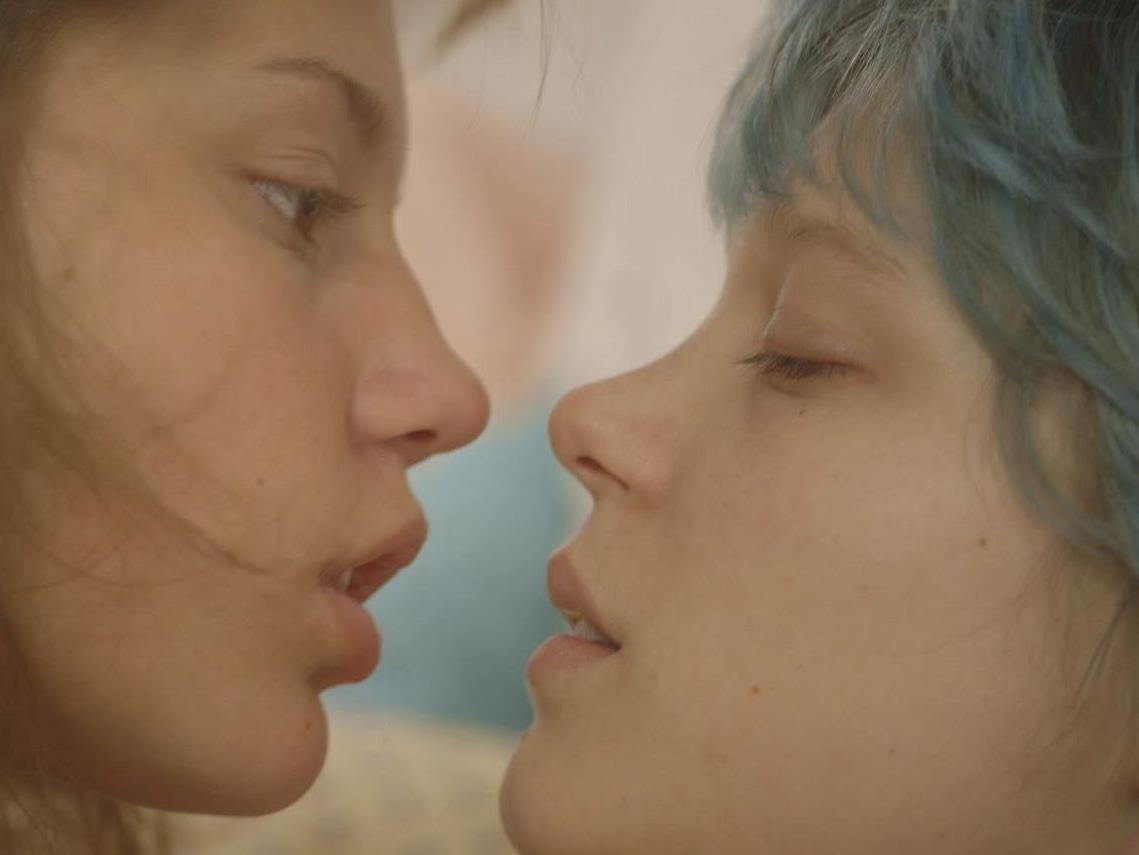Mirroring its uneasy central character Adèle (Adèle Exarchopoulos, I Used to Be Darker), the film hovers around the edges, not quite expressing what it wants to be. Scenes of ordinariness – of Adèle gossiping with pals, participating at school, and connecting with and then rejecting a boy – comprise its establishing content, the mundane punctuated only briefly by the messiness and awkwardness of teenage life. A confused reaction to male attention, a shared glance with a stranger on the street, and a stolen moment with a classmate all show, however, that the film isn’t destined to dwell among the routine.
Suddenly, with the vibrant shock of blue hair that catches Adèle’s eye, Abdellatif Kechiche’s (Black Venus) fifth feature blossoms; now, everything is embraced and celebrated, and nothing is avoided or kept from attention. Coming of age and coming out, Adèle falls swiftly and seriously in love with the sapphire-topped Emma (Léa Seydoux, Sister), their romance fast, frenetic, and failing to adhere to expectations. From the erotic heights of lust, to the vulnerable but comfortable status quo of loving commitment, to the shattering hurt and screaming anger that comes when things go wrong, their relationship shows affection and attachment in all its complexities and extremes.
Poetic and passionate, Blue Is the Warmest Colour remains a love story, plain and simple; it is the bond between Adèle and Emma, in the great times and the awful encounters, that matters above all else. Similarly, the controversy courted by the 2013 Palme d’Or winner, especially by its lengthy and graphic sex scenes, counts for little in context of the finished product – nor does the sexual orientation of the characters. Over the course of the film’s expansive, detail-filled 179-minute running time, the adaptation of Julie Maroh’s acclaimed graphic novel of the same name lays bare everything that people give to their pairings, as the women do now and others have before them: their hearts, hopes, friendships, futures and flesh included.
Blue Is the Warmest Colour’s Cannes triumph was accompanied by unusual circumstances, the duo of actresses receiving the award alongside the writer/director for the first time in the festival’s history. This overt act recognised their key role in conveying the honesty and heartbreak that sears the raw romance into the audience’s minds and memories, their efforts truly the crux of the film’s resonance. In owning the desire and difficulty at the film’s centre, in giving their all for the explicitness of their on-screen coupling, and in never shying away from the hard and horrific, their performances transcend innate chemistry to breathe and bloom with authenticity and intensity. Their portrayals are sensual and sensitive, regardless of their frequently undressed forms. Seydoux simmers with world-weariness, whilst Exarchopoulos explodes with youthful ambiguity.
The prominence of the stars also stems from Kechiche’s cinematic perspective, the lens of his cinematographer Sofian El Fani (My Shoes) never roaming far from either figure. With purpose the film thrusts its protagonists to the fore, Exarchopoulos’s expressive face constantly dwarfing the frame, to cement the closeness of the underlying story. In its assured, blue-heavy visuals, as well as its Ghalia Lacroix (Games of Love and Chance) co-adapted script, it never fails to emphasise their interplay as its point of focus. That Lacroix also acted as the feature’s editor assists in this regard, well-timed cuts working to accentuate the feeling of familiarity.
Indeed, that’s what Blue is the Warmest Colour is: a candid, challenging ode to the fragility of intimacy, for better and for worse, and for all its initial withholding and eventual torrent of emotion. The film’s inspiration, screenplay, direction and performances all re-iterate this, but without repetition. There’s nothing monotonous about its exhaustively mature and moving evocation of the vagaries of love. In the end, there’s nothing left unsaid or unexplored, and no blistering sentiment left uncovered.
Rating: 4.5 out of 5
Blue Is the Warmest Colour (La vie d’Adèle)
Director: Abdellatif Kechiche
France / Belgium / Spain, 2013, 179 mins
Brisbane International Film Festival
November 13 – 24
http://www.biff.com.au/
In general release: 13 February 2014
Distributor: Transmission
Actors:
Director:
Format:
Country:
Release:





